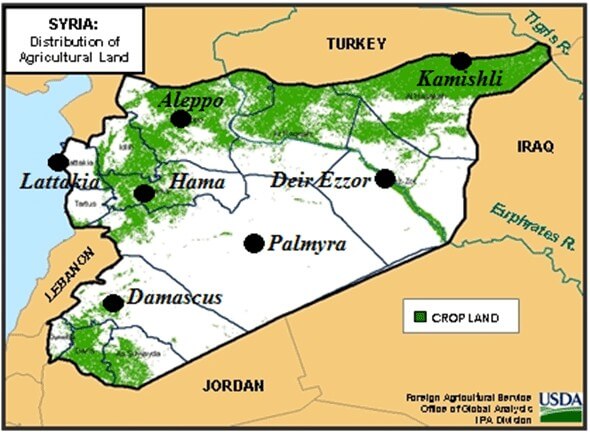Water availability is expected to become a central element in economic development and government policies in the years to come. Indeed, water stress and scarcity are already making an impact on economic growth and geopolitical stability. Migrations are being driven by political volatility, linked to rainfall decrease and extended droughts. At the end of the line, big cities must be prepared to accommodate more people, pushing governments to the edge as far as water and sanitation concerns.
Water resources in most cases do not belong to a single nation or region, instead, they usually cross political jurisdictions through rivers, lakes and aquifers. This situation, accompanied by the depletion of resources, can turn water resources into an even more valued commodity in the near-term, with the potential to trigger more political conflicts.
An example of how water resources exhaustion can drive political conflicts is the civil war in Syria. Evidence shows that an explosive mix of interrelated factors, one of which is water resources exhaustion, ended up leading to the civil conflict.
Before the Syrian water crisis took place, the country had registered an unprecedented growth in food production, supported by subsidies for agricultural activities. However, at the same time, a decrease in rainfall unfolded, and extended rainless periods started to dent rural activities. By 2011, about 60% of the Syrian territory had not seen any important rainfall for about 5 years. This period especially affected the rural areas, shown in Figure 1, whose population depended on farming activities to a large extent.

The rampant rate of food production, buoyed by a poor water management system in an already water-stressed region, ended up displacing around 1.5 million Syrians[1]. The drought especially affected the northeast area of Hasakah, shown in red in Figure 2, but also some regions in the south, as seen in the same image.

The Syrian example shows what the lack of effective water management policies in a water-stressed area could lead to. Once the toughest drought arrived in 2006, there was little groundwater to cushion the effects of the rainless period, and no efficient water management strategies in the horizon to avoid the violent part of the story.
Water stressed countries like Syria and Yemen, are critically vulnerable to increasing water shortages and further political conflict. In the same way, migration is expected to rise, as the consequences of the climate crisis keep challenging vulnerable areas[2]. In 2018, the World Bank estimated that climate change will generate around 143 million more migrants in Latin America, sub-Saharan Africa, and Southeast Asia by 2050[3].
Migrants in general tend to head to global cities in search of opportunities like shown in Figure 3.

With this situation in mind, a fresh approach to climate change migration is needed. Feasible solutions start by targeting alternatives at the community level to assess opportunities for individuals and household displacements. Empowering communities by incorporating vulnerable populations in the production of knowledge, and in policy and planning processes, would encourage them to actively participate in the creation of resilient societies.

As mass urbanization and increasing vulnerability are key challenges to address in Megacities[4], they must keep-up on their ability to provide basic services to their population. This means counting on ample infrastructure and sound water management systems to cover the growing service demand. The task does not only center around the capacity to provide drinking water or wastewater treatment but also for the prevention and mitigation of increasing risks, which include water scarcity.
The new approach must be based on the conservation of resources, introducing small-scale, decentralized, ecologically aware, and low-cost technologies. Efforts must be directed towards initiatives that close material cycles, especially between agricultural activities and the cities[5]. Increasing irrigation efficiency of the green spaces and using treated wastewater for landscaping purposes are some basic measures to take into consideration. The use of treated water is in some cases a more effective and convenient solution than building new dams as a water source[6].
A sustainable Megacity with a flourishing economy needs strong social and environmental policies with a long-term perspective, in which the role of water is often an important contributor to social and political stability.
At BOSAQ, our water experts actively participate in the process of tackling the water crisis challenge. We put together experience with sustainable and decentralized technology to close the water loop and provide sustainable clean water with minimal environmental impact and maximum social benefit for communities and the industry.
[1] P. H. Gleick, ‘Water, Drought, Climate Change, and Conflict in Syria’, Weather Clim. Soc., vol. 6, no. 3, pp. 331–340, Jul. 2014, doi: 10.1175/WCAS-D-13-00059.1.
[2] K. Warner, M. Hamza, A. Oliver-Smith, F. Renaud, and A. Julca, ‘Climate change, environmental degradation and migration’, Nat. Hazards, vol. 55, no. 3, pp. 689–715, Dec. 2010, doi: 10.1007/s11069-009-9419-7.
[3] J. Podesta, ‘The climate crisis, migration, and refugees’, Brookings, Jul. 25, 2019. https://www.brookings.edu/research/the-climate-crisis-migration-and-refugees/ (accessed Jun. 30, 2020).
[4] M. DePaul, ‘Climate Change, Migration, and Megacities: Addressing the Dual Stresses of Mass Urbanization and Climate Vulnerability’, Paterson Rev. Int. Aff., vol. 12, p. 18, 2012.
[5] J. Niemczynowicz, ‘Megacities from a Water Perspective’, Water Int., vol. 21, no. 4, pp. 198–205, Dec. 1996, doi: 10.1080/02508069608686515.
[6] M. Ahmadi and M. Zarghami, ‘Should water supply for megacities depend on outside resources? A Monte-Carlo system dynamics simulation for Shiraz, Iran’, Sustain. Cities Soc., vol. 44, Oct. 2018, doi: 10.1016/j.scs.2018.10.007.